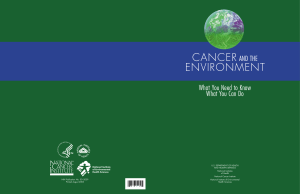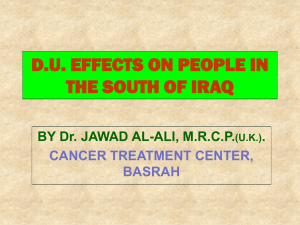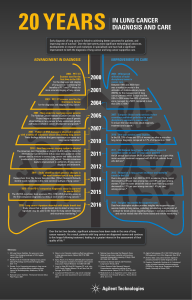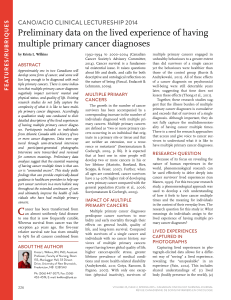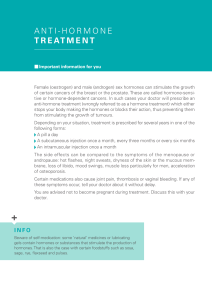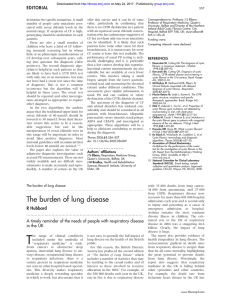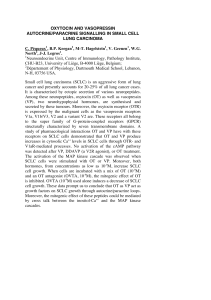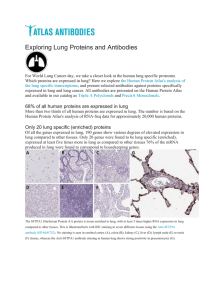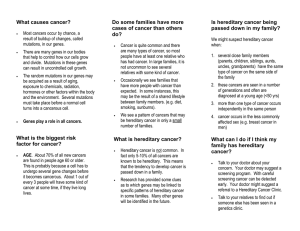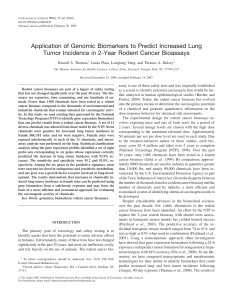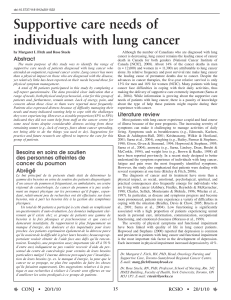Cancer and the Environment, Minnesota Department of Health
publicité
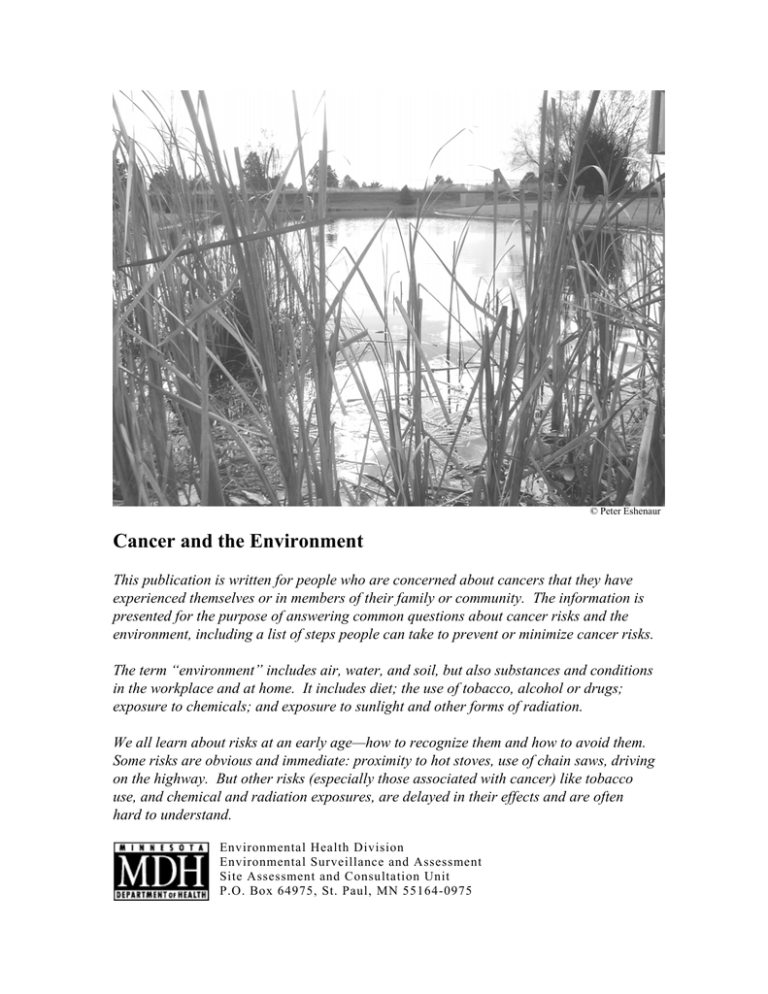
© Peter Eshenaur Cancer and the Environment This publication is written for people who are concerned about cancers that they have experienced themselves or in members of their family or community. The information is presented for the purpose of answering common questions about cancer risks and the environment, including a list of steps people can take to prevent or minimize cancer risks. The term “environment” includes air, water, and soil, but also substances and conditions in the workplace and at home. It includes diet; the use of tobacco, alcohol or drugs; exposure to chemicals; and exposure to sunlight and other forms of radiation. We all learn about risks at an early age—how to recognize them and how to avoid them. Some risks are obvious and immediate: proximity to hot stoves, use of chain saws, driving on the highway. But other risks (especially those associated with cancer) like tobacco use, and chemical and radiation exposures, are delayed in their effects and are often hard to understand. Environmental Health Division Environmental Surveillance and Assessment Site Assessment and Consultation Unit P.O. Box 64975, St. Paul, MN 55164-0975 What is cancer? Cancer is not a single disease; it is a group of more than 100 different diseases. Cancer is the uncontrolled growth and spread of abnormal cells in the body. Different types of cancer have differing rates of occurrence, causes, and chances for survival. The development of cancer is a multi-step process, starting with genetic changes in cells, followed by cell division and growth over time. The time from genetic change to the development of cancer, known as the “latency period,” is usually decades long, often 30 years or longer. This means that many cancers diagnosed today may be due to genetic changes that occurred in cells a long time ago. Cancer can develop in individuals of all ages, but is most commonly found in people who are older than 60 years. Nearly one half of all Minnesotans will develop cancer at some point in their lives. Because people are living longer, the risk of developing cancer is increasing. What causes cancer? Since cancer is not a single disease, it does not have a single cause. There are a variety of causes (better known as “risk factors”). These factors act over many years to increase an individual’s chance of developing cancer. They can include such things as age, race, gender, other genetic factors, chemical exposures, diet, radiation, exposure to tobacco, and reproductive history. For many cancers, such as breast and colon cancer, genetics play a role. This means that a family history can be a risk factor for some types of cancers. It is not unusual for several cases to occur within a family. In addition, there are things we do in our daily lives that can increase our chance of developing cancer. These factors, sometimes called “lifestyle factors,” include: cigarette smoking; heavy drinking; and eating foods that have excess calories, high fat, and low vegetable intake. Other lifestyle factors that increase risk have to do with reproductive patterns, sexual behavior, and sunlight exposure. Cigarette smoking is a leading cause of cancer deaths in the U.S. today. In addition to being responsible for 80 to 90 percent of lung cancers, cigarette smoking is also associated with leukemia and cancers of the mouth, pharynx, larynx, stomach, esophagus, pancreas, kidney, bladder, cervix, and endometrium (lining of the uterus). Approximately 30 percent of all cancer deaths are related to smoking, and the risk of dying from lung cancer is 10 to 20 times higher for smokers compared to non-smokers. In fact, smoking is the most preventable cause of death in our society. 2 Are cancer rates increasing in the U.S.? In Minnesota? From the 1930s until 1991, there was a steady rise in the overall cancer death rate in the U.S. The major cause of this rise was the increase in lung cancer; this was strongly associated with increases in smoking. Death rates for many cancers—other than lung cancer—declined by 15 percent between 1950 and 1990. These decreases are due to improvements in the early detection and treatment of specific types of cancers, such as breast, colon, and cervical cancers. Between 1990 and 2000 the national cancer death rate fell 7.6 percent. In Minnesota, the incidence of cancer (new cases) is monitored by the Minnesota Cancer Surveillance System. Created by the Minnesota Legislature in 1987, this statewide system collects information on all new cancers diagnosed in Minnesotans. Minnesota’s cancer rates are similar to the national rates for most types of cancer. However, our lung cancer rates are lower compared to the U.S. population. This may be due to the fact that smoking prevalence in Minnesota was lower years ago. Today our smoking rate is similar to the national average and the gap between the national lung cancer rate and Minnesota’s rate is closing. 3 In men, cancer incidence has declined in Minnesota since 1988, largely due to decreases in colorectal, stomach and lung cancer. Prostate cancer incidence increased in the early 1990’s when a new screening test found many cancers that would not have been found until later, or may never have become apparent, without screening. In women, overall cancer incidence rates increased, largely due to increases in breast and lung cancer, which outweighed decreases in colorectal, stomach and cervical cancer. Despite these increases, breast cancer deaths decreased due to earlier diagnosis and improved treatment. Odds of Cancer in Minnesota Males Prostate Lung Colo-rectal Bladder Any Cancer Diagnosis 1 in 6 1 in 13 1 in 16 1 in 26 1 in 2 Odds of Cancer in Minnesota Females Death 1 in 27 1 in 15 1 in 40 1 in 125 1 in 4 Breast Colo-rectal Lung Uterine Any Cancer 4 Diagnosis 1 in 7 1 in 17 1 in 20 1 in 33 9 in 20 Death 1 in 29 1 in 40 1 in 23 1 in 167 1 in 5 In Minnesota, as in other parts of the country, racial differences have been observed. African American men have the highest cancer rates in Minnesota. Among American Indians, smokingrelated cancers of the lung, larynx, and oral cavity, as well as prostate, colorectal and cervical cancers are unusually common. What about cancer in children? Many pediatric cancers occur early in life and parents want to know why. Nearly 1 in 450 children will be diagnosed with cancer before the age of 15. Although some childhood cancers are associated with specific genetic, prenatal, and environmental factors, in most cases the causes remain largely unknown. It is believed that the organ systems of children are especially vulnerable to injury when undergoing periods of rapid growth and development. Factors that are suspected of playing a role in childhood cancers include genetics, infectious diseases, prenatal conditions, environmental pollutants, radiation, and use of medications. However, few studies have been able to show a consistent association between cancer and these factors. The types of cancer most often seen in children are different from those seen in adults. The three most common types of cancer in children are: (1) leukemias; (2) tumors of the brain and nervous system; and (3) lymph node cancers. In contrast, the most common types of cancer in adults are: (1) lung cancer; (2) breast cancer; (3) colon or rectal cancer; and (4) prostate cancer. © Peter Eshenaur 5 What about chemicals in the environment? Lifestyle factors present some significant risks. However, exposures to certain chemicals in the environment, at home, and at work may also contribute to an individual’s risk of developing cancer. Benzene, asbestos, vinyl chloride, and arsenic are examples of toxic substances that can increase the risk of cancer to those who are exposed. The International Agency for Research on Cancer (IARC) has classified these substances as “known human carcinogens.” Some chemicals have been shown to cause cancer in animals, but there is not enough evidence to show that these chemicals cause cancer in humans. These chemicals are classified by IARC as “possible or probable (suspected) human carcinogens.” Most of what we know about chemicals and cancer in humans comes from scientists’ observations of workers. Historically, the most significant exposures to cancer-causing chemicals have occurred in workplaces where large amounts of toxic chemicals were used. That is why safe work practices, personal protection, ventilation, and other controls are so important in protecting workers and their families. The amount of toxic chemicals found in food, air, and drinking water are typically much lower than in the work environment. Therefore, cancer risk from environmental exposures is thought to be very low compared to the risk in occupational settings. In fact, the cancer risk from environmental exposures is so low that it is difficult to measure in scientific studies. Scientists have compiled a list of substances that are either known or suspected of causing human cancer in The 10th Report on Carcinogens published in 2003. The report also describes where these substances are found in our environment. For a condensed list of these substances, see Table 1 at the end of this publication. The complete report is available on the internet at: http://ntp-server.niehs.nih.gov/NewHomeRoc/AboutRoC.html How do I interpret information in the news about cancer and the environment? There are several principles to keep in mind when you read an article or hear a news report about a new scientific study: *A single study on the causes of cancer is seldom conclusive. Scientists look for multiple studies with consistent results before drawing conclusions. Each new study that you hear or read about adds to the body of evidence that scientists use for understanding the causes of cancer. *The dose determines the poison. Scientific results are usually specific to a particular dose or route of exposure to a specific population being studied. Yet each individual’s chance of getting cancer from an exposure will be different depending on: • The amount of a contaminant to which a person is exposed • The length of time a person is exposed • The number of times a person is exposed • How the person was exposed, such as by eating, breathing, or touching the substance 6 * Realize that uncertainties are always present in any study of environmental exposure and cancers. Due to the long latency period of cancer development, it is often difficult to collect information regarding exposures years or decades after they occur. Individual genetic differences, age, gender, and health status interact with lifestyle habits, as well as environmental exposures -- causing some people to be more sensitive to developing cancer than others. Because it is difficult to account for all of these variables and how they interact, “uncertainties” exist in the study of cancer and environmental risk factors. *“Safety factors” or “uncertainty factors” are used to set acceptable levels of exposure. These factors take into account that certain individuals might be more sensitive to chemicals because of age (children and the elderly), genetic make-up, gender, diet, or health status. In addition, if mice or rats were used to test the chemical, the possibility is considered that people may be more sensitive to the cancer-causing effects of the substance than the rodents. To ensure that the acceptable level of exposure will protect the public, government agencies use safety factors that result in setting acceptable levels of exposure as much as 10,000 times lower than the level that causes cancer in mice and rats. *Sometimes it is necessary to weigh risks vs. benefits. Some drugs are prescribed even though they may increase the risk of cancers in later years. An example is the use of certain drugs to treat cancer that increase the risk of secondary cancers. In these situations, the immediate benefits of treating an often imminently life-threatening disease have been determined to outweigh the risks of developing cancer several years later. Before taking any medication that increases the risk of cancer in future years, discuss the risks versus the benefits with your physician. What is being done to control cancer-causing chemicals? Strict federal and state standards have been set to minimize our exposures to cancer-causing chemicals. On the federal level, the U.S. Environmental Protection Agency (EPA) is charged by the U.S. Congress to set environmental regulatory standards to protect human health and the health of the environment from substances released into air, water or soil. In the State of Minnesota, the Minnesota Pollution Control Agency (MPCA) and the Minnesota Department of Health (MDH) have state programs to meet or exceed the federal standards to protect human health and the health of the environment. Activities include monitoring of air, water, and soil, conducting scientific research, setting standards, proposing rules, and enforcement. MDH, Division of Environmental Health protects people from environmental hazards in drinking water, the home, workplace, and community. Activities include monitoring health trends, assessing environmental exposures in communities, evaluating the scientific evidence and recommending safe exposure levels or other actions to protect public health. MDH has established standards for chemicals in air (called Health Risk Values) and water (called Health Risk Limits) specifying levels that are considered safe. MDH also provides education about hazardous substances for communities and health professionals. 7 Many hazardous substances, such as certain pesticides and metals, continue to be found in our environment from past use. Dioxin, for example, is widespread and persistent in the environment. Small amounts of dioxin can be found in our food and in our bodies. It will take many years for such persistent chemicals to break down or be removed from the environment. Ironically, one of the most potent and well-known cancer-causing chemicals, tobacco, is still largely uncontrolled. There are over 40 known or suspected carcinogens present in tobacco smoke. Progress has been made, however, in controlling exposure to secondhand smoke in public buildings and on the job. Some carcinogens in the environment occur naturally and are much more difficult to control. Arsenic in underground rock can get into drinking water wells. Radiation from the sun is also a strong cancer-causing agent. Sometimes our own actions offer the best control for exposure. When necessary, we can purify drinking water or use clothing and sunscreen to protect ourselves from the sun. Many other agencies work to protect the public from harmful environmental exposures. For a listing of some of these agencies, see “Where can I get more information?” at the end of this booklet. © Peter Eshenaur What if I see an unusual number of cancers among my neighbors or co-workers? Could it be something in our environment? Cancer is a personal tragedy for those affected. But what may appear to be an “outbreak” of cancer does not, by itself, signal a special risk related to something in the environment. Unfortunately, cancer is common in our population, and differing types of cancer have differing causes. 8 It is not unusual to observe many cases of cancer in a single community or neighborhood, particularly if the community is aging. In fact, using information from our cancer surveillance system, we know that cancers frequently occur in clusters. Clusters often occur by chance and cancer cases are not evenly distributed throughout the population. At MDH, patterns of disease are investigated by epidemiologists who study the frequency, distribution, risk factors, and control of diseases in populations. Epidemiologists look for an unusual pattern of a specific type of cancer, rather than several different types. They find out whether the specific type of cancer is a primary cancer or a cancer that is the result of metastasis (spread from another organ in the body). Using statistical methods, epidemiologists can determine whether a reported excess of cancer in a population is really more than would normally be expected to occur. They must also take into account other characteristics of the population that can affect disease patterns, such as age, gender and heredity. Most of our knowledge about the causes of cancer in people comes from studying large populations. Even our best scientific methods cannot tell us the cause of cancer in an individual, or in a small group of individuals. © Peter Eshenaur What steps can I take to minimize my cancer risks? We can’t eliminate all risks in our lives. But we can, to a certain extent, manage them by adopting healthy lifestyles. MDH endorses the following American Cancer Society recommendations to prevent or minimize cancer risks: * Stop smoking and avoid all tobacco products * Avoid excessive exposure to sunlight * Eat more fruits and vegetables, along with a low-fat, high-fiber diet 9 * Limit consumption of smoked and nitrite-cured foods * Limit alcohol intake * Avoid obesity * Exercise regularly * Have routine physical exams since not all cancers have obvious symptoms * Practice early detection—learn to practice self-exam and seek prompt medical attention for changes in your body which include: • A thickening or lump in any part of your body • An obvious change in a wart or mole • A sore that does not heal • A nagging cough or hoarseness • A change in bowel or bladder habits • Indigestion or difficulty swallowing • Unexplained changes in weight • Unusual bleeding or discharge How Can I Protect Myself from Toxic Exposures in the Environment? At Home: We spend about 90% of our time indoors. The air inside your home may be more polluted than the air outside. If you use chemicals in the home, such as pesticides, paints, paint thinners, cleaning solvents, or preservatives, the following steps may decrease exposure: • Read labels and follow directions carefully • Use these chemicals only in a well ventilated environment— outdoors when possible • Throw away partially full containers of old or unneeded chemicals (following community guidelines for disposal of household hazardous waste) • Make substitutions for less toxic substances whenever possible • Have the basement of your home tested for radon. An estimated 1 out of 3 homes in Minnesota contain radon gas. For a list of local city or county agencies that distribute radon information and test kits, contact MDH at: 1-800-798-9050 or 651-215-0909. Or log on to the internet at: http://www.health.state.mn.us/divs/eh/indoorair/radon/index.html If you have an older home (built before 1978)… • Your home may contain flooring, roofing, insulation or other products with asbestos -- do not disturb or remove any asbestos containing material. For more information, contact MDH at: 651-215-0900. Or log on to the asbestos web site: http://www.health.state.mn.us/divs/eh/asbestos/index.html • Old paint may contain lead or other toxic metal. Peeling paint should be safely removed or covered. At Work: • Be aware of any carcinogenic substances used in your workplace • Participate in work hazard communication training programs • Read labels and take precautions as directed • Use recommended personal protective equipment 10 In Your Community: • Stay informed. If you have concerns regarding pollutants in your community, contact the agencies responsible for safeguarding our environment and our health, such as MPCA and MDH, Division of Environmental Health. • Members of tribal communities may contact their Natural Resource Management or Environmental Health departments. Where can I get more information? National Cancer Institute (NCI): http://www.cancer.gov The largest cancer research organization in the country; supports research at universities, hospitals, foundations, and businesses throughout the U.S. and abroad. • Cancer Prevention: http://www3.cancer.gov/prevention/ • NCI’s SEER Program is the most authoritative source of information on cancer incidence and survival in the U.S.: http://www-seer.ims.nci.nih.gov • NCI’s Toll-Free Cancer Information Service for information about cancer and to request publications: 1-800-4-CANCER/1(800) 422-6237 National Institute of Environmental Health Sciences (NIEHS): http://niehs.nih.gov Established to reduce human illness caused by unhealthy substances in the environment. Activities include biomedical research, prevention, and intervention programs along with training, education, and community outreach efforts. • National Toxicology Program (NTP): Coordinates toxicology research and testing activities within the U.S. Department of Health and Human Services (DHHS). Publishes a biennial Report on Carcinogens: http://ntp.niehs.nih.gov/index.cfm?objectid=03C9B512-ACF8-C1F3-ADBA53CAE848F635 Centers for Disease Control and Prevention (CDC): http://www.cdc.gov/ CDC is an agency of the U.S. DHHS that is charged with promoting health and quality of life by controlling disease, injury, and disability: • National Center for Environmental Health (NCEH) Health Line: 1(888) 232-6789 http://www.cdc.gov/nceh/ncehhome.htm • For information about the National Report on Human Exposure to Environmental Chemicals, March 2002, call 1(866) 670-6052 or log on to: http://www.cdc.gov/nceh/dls/report Agency for Toxic Substances and Disease Registry (ATSDR): http:// www.atsdr.cdc.gov ATSDR is an agency of the U.S. DHHS that advises the EPA on hazardous waste issues. ATSDR has educational fact sheets about toxic chemicals. • ATSDR Informational Center: 1(888) 422-8737 The International Agency for Research on Cancer (IARC): http://www.iarc.fr IARC is part of the World Health Organization (WHO) and has a mission to coordinate and conduct research on the causes of human cancer. 11 Environmental Protection Agency (EPA): http://www.epa.gov A government regulatory agency charged by the U.S. Congress to protect human health and safeguard the natural environment: • Indoor Air Quality: http://www.epa.gov/iaq • Envirofacts Warehouse: http://www.epa.gov/enviro • Environmental Atlas: http://www.epa.gov/ceisweb1/ceishome/atlas • EPA National Pesticide Information Center: http://npic.orst.edu/ Phone: 1(800) 858-7378 • EPA Superfund Hotline for hazardous waste: 1(800) 535-0202 Cornell University Program on Breast Cancer and Environmental Risk Factors (BCERF) in New York State: http://envirocancer.cornell.edu A program developed by faculty and staff from Cornell University in Ithaca, New York, and the Joan and Sanford Weill Medical College of Cornell University in New York City. The website provides information about environmental risk factors and breast cancer. The American Lung Association: http://www.lungusa.org A voluntary health organization in the United States that has many programs and strategies to fight all forms of lung disease, which include funding professional research and promoting environmental health. • Facts about lung cancer: http://www.lungusa.org/diseases/ Food & Drug Administration (FDA): http://www.fda.gov/ The FDA monitors products for safety and helps safe and effective products reach the market in a timely way. • The National Center for Toxicological Research: http://www.fda.gov/nctr • FDA Consumer Hotline: 1(800) 532-4440 Occupational Safety and Health Administration (OSHA): http://www.osha.gov OSHA is an agency of the U.S. Department of Labor charged with preventing work-related injuries, illnesses, and deaths. • OSHA information: 1(800) 321-6742 National Institute for Occupational Safety and Health (NIOSH): http://cdc.gov/niosh An agency of the CDC that researches and makes recommendations to prevent work-related disease and injury. • NIOSH information: 1(800) 356-4674 The Harvard School of Public Health: http://www.yourcancerrisk.harvard.edu/ An interactive website designed to help you identify and decrease your personal risk factors for several types of cancer. This information was prepared in cooperation with the U.S. Agency for Toxic Substances and Disease Registry. To request this document in another format, call: (651) 215-0700 or toll-free 1–800-657-3908, press 4 and leave a message; TDD: (651) 215-0707 or 1-800-627-3529. 12 Table 1. Categories, Source, and Associated Sites of Known or Suspected Carcinogens Substance Aflatoxins Alcoholic Beverages Arsenic Asbestos Benzene Benzidine and Benzidine-based Dyes Diesel Exhaust Particles Dioxin (TCDD) Formaldehyde Ionizing Radiation Ultraviolet Radiation Medical Drugs: Cyclophosphamide, Chlorambucil, Melphalan Source of Exposure Toxins from fungi in contaminated foods (peanuts and grains) or contaminated grain dust (agricultural workers exposed) Consumption of more than 2 alcoholic drinks per day Naturally occurs in soils and groundwater from the weathering of rock. Industrial uses: wood preservative, glass, and pesticides. Exposure can occur through food and drinking water, automobile emissions or emissions from industrial facilities, and smoking. Air-born microscopic fibers released from products, mostly found in homes and buildings, also brake linings. Used in chemical and drug industries, and as a gasoline additive. Found in gasoline vapors, auto exhaust, and cigarette smoke. Exposure can occur near dye and pigment plants where wastes may be discharged. Diesel automobiles, trucks and engines By-product during paper and pulp bleaching, incineration of wastes, forest fires, and in some pesticides and wood preservatives. Most human exposure is dietary: meat, dairy, fish. Used in construction products, textiles, disinfectants, coatings, moldings, furnishings; exhaust from cars, power plants, wood stoves, kerosene heaters and cigarettes. Medical X-rays, rays entering the earth’s atmosphere, naturally radioactive substances Sun, sunlamps, or tanning beds Cancer therapy agents Cancer Site Associated with Exposure Liver Mouth, throat, voice-box, and esophagus; possible link with breast and liver cancer. Skin, lung, bladder, kidney and liver Lung, larynx and lining of the lung (mesothelioma) Leukemia Bladder Lung Cancers, no specific site Nasophyarygeal, brain Leukemia, breast, thyroid, lung, stomach, and other organs at very high doses Skin-melanoma Increased occurrence of secondary cancers Endometrium (lining of the uterus) Estrogen Treatment of menopause and gynecologic conditions Tamoxifen Synthetic hormone Diethylstilbestrol (DES) Metals: Cadmium and cadmium compounds Synthetic estrogen Industrial processes, contamination can be released into air, surface water, ground water and topsoil. Lung Nickel and Nickel Compounds Steel, dental fillings, copper, brass, glazes, and storage batteries. Found in air, water, soil, food, and consumer products. Lung, nasal cavity, and larynx Endometrium (lining of the uterus) Cervix and vagina; in daughters exposed prenatally 13 Chromium VI Compounds Used in corrosion protection, electroplating, textile and tanning, paper, pigments, roofing, and glass. Contaminant in soil, air, water, food. Lung Beryllium Compounds Industrial uses: aerospace and defense, electrical components, aircraft brakes, fuel additive, ceramics, glass, fiber optics and plastics. Exposure occurs through burning of coal and fuel oil. Lung Lead Compounds Lead acetate used in dyes, metal coatings, paints, varnish, pigments. Found in contaminated soils, water, dust, food and paint chips. Lung, stomach Obesity Pesticides Polycyclic Aromatic Hydrocarbons (PAHS) Radon . Solvents Tobacco Vinyl Chloride Used for agricultural practices, restricted use. About 20 out of 600 are carcinogenic: e.g. lindane, ethylene oxide, DDT, chlorophenoxy herbicides, toxaphene, hexachorobenzene, lead acetate. Produced from burning organic fuels such as wood and gasoline, and waste incinerators. Also in diesel exhaust, coke oven emissions, cigarette smoke, and charcoal-broiled food. Naturally occurring radioactive gas seeps into lower levels of homes and buildings from soils. Industrial solvents: carbon tetrachloride, chloroform, methylene chloride, tetrachloroethylene and trichloroethylene; used in paint thinners, paint and grease removers, and dry cleaning solvents. Cigarettes, cigars, chewing tobacco, snuff and environmental tobacco smoke (ETS) Major release is from plastics industry. Also found in groundwater near solvent waste sites. Colon, esophagus, stomach, gall bladder, endometrium, kidney, and breast Lymph system, prostate, and stomach, increased cancers among highly exposed occupational groups Lung, genital-urinary Lung Lung, liver Lung, bladder, oral cavity, throat, voice box, esophagus, lip, pancreas, and nasal sinus Liver, brain, blood, and lung Viruses and Bacteria: Helicobactor pylori Waste-tainted food or water, oral contact. Stomach Human papilloma-virus Sexually transmitted virus Cervix Hepatitis B and C viruses Direct contact with blood and/or body fluids Liver Epstein-Barr virus Contact with oral secretions Lymphoma Direct contact with blood and/or body fluids Kaposi’s Sarcoma, endothelial layer of blood, lymph Human Immunodeficiency virus system (HIV) Inhalation of small air-born particles from wood Lung Wood Dusts Information in this chart is based on materials from the National Cancer Institute and National Institute for Environmental Health Sciences 14







